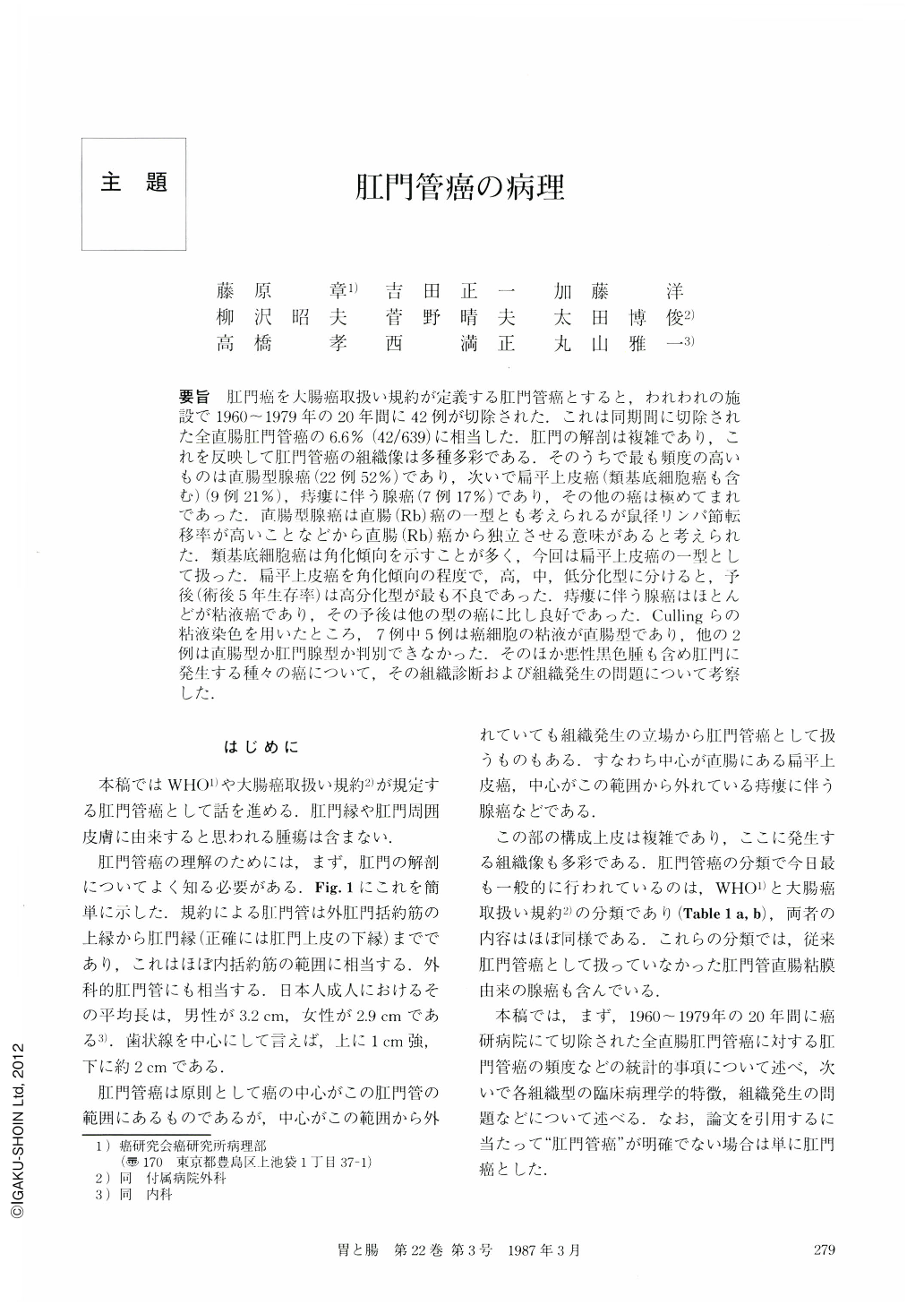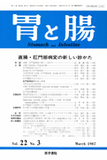Japanese
English
- 有料閲覧
- Abstract 文献概要
- 1ページ目 Look Inside
- サイト内被引用 Cited by
要旨 肛門癌を大腸癌取扱い規約が定義する肛門管癌とすると,われわれの施設で1960~1979年の20年間に42例が切除された.これは同期間に切除された全直腸肛門管癌の6.6%(42/639)に相当した.肛門の解剖は複雑であり,これを反映して肛門管癌の組織像は多種多彩である.そのうちで最も頻度の高いものは直腸型腺癌(22例52%)であり,次いで扁平上皮癌(類基底細胞癌も含む)(9例21%),痔瘻に伴う腺癌(7例17%)であり,その他の癌は極めてまれであった.直腸型腺癌は直腸(Rb)癌の一型とも考えられるが鼠径リンパ節転移率が高いことなどから直腸(Rb)癌から独立させる意味があると考えられた.類基底細胞癌は角化傾向を示すことが多く,今回は扁平上皮癌の一型として扱った.扁平上皮癌を角化傾向の程度で,高,中,低分化型に分けると,予後(術後5年生存率)は高分化型が最も不良であった.痔瘻に伴う腺癌はほとんどが粘液癌であり,その予後は他の型の癌に比し良好であった.Cullingらの粘液染色を用いたところ,7例中5例は癌細胞の粘液が直腸型であり,他の2例は直腸型か肛門腺型か判別できなかった.そのほか悪性黒色腫も含め肛門に発生する種々の癌について,その組織診断および組織発生の問題について考察した.
A tumour of the anal canal as difined by WHO and JRSCCR (Japanese Research Society for Carcinoma of Colon and Rectum) is a tumour whose center is located in or which is supposed to have originated from the anal canal. During a period of 20 years, 1960-1979, 42 malignant epithelial tumours of the anal canal including two melanomas had been resected at the Cancer Institute Hospital. These 42 malignant tumours represented 6.6% of the total number of tumours (639).
Though several types of tumours are found in this area, rectal type adenocarcinoma was the most frequent (52%), then squamous cell carcinoma including basaloid carcinoma (21%) and adenocarcinoma associated with anal fistula (17%). The incidence of the last tumour, however decreased to 9%, when only the cases with a long history (more than 10 years) of anal fistula were considered. Other types were extremely rare.
A rectal type adenocarcinoma of the anal canal is primarily a rectal carcinoma, but it carries with it a higher incidence of metastasis to the inguinal nodes and a higher possibility of blood-borne metastasis through the systemic veins than does a rectal carcinoma originating from the area above the anal canal. For this reason these two types of rectal carcinoma should be distinguished from each other from a clinical point of view.
In this article, basaloid carcinomas were regarded as poorly differentiated type of squamous cell carcinomas. The prognosis for patients who had these basaloid carcinomas removed by operation was better than for patients who had moderately or well-differentiated type squamous cell carcinomas.
Patients with adenocarcinomas associated with anal fistula (mostly of the mucinous type) enjoyed a favorable five-year survival rate (86%), compared to patients with rectal type adenocarcinoma and squamous cell carcinoma.
In five out of seven cases of adenocarcinomas associated with anal fistula, the cancer cells contained O-acylated sialomucin, which suggested they were of rectal mucosal origin. On the other hand, the cells of the rest two cases were deficient in O-acylated sialomucin, which suggested they were either of rectal-mucosa or of anal gland origin.
Further, characteristics of each type of the tumour, and several problems on histological diagnosis and histogenesis of the tumours were discussed.

Copyright © 1987, Igaku-Shoin Ltd. All rights reserved.


